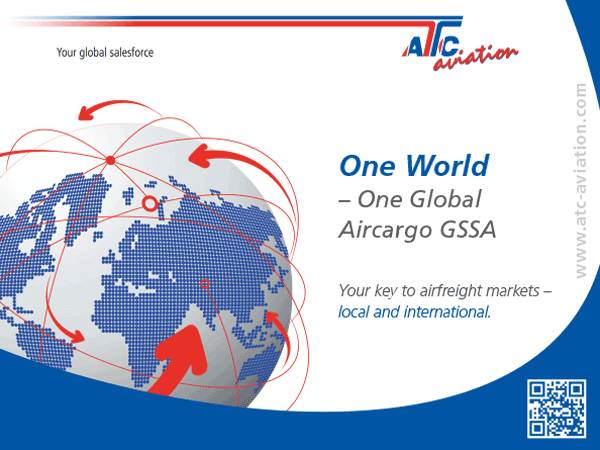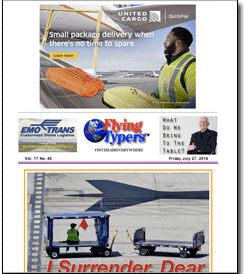 |
 #INTHEAIREVERYWHERE
#INTHEAIREVERYWHERE |
|
| Vol.
17 No. 46 |
Monday
July 30, 2018 |
 |
|
 A
giant honey colored teddy bear welcomes travellers at Hamad International
Airport in Doha, Qatar. A year into a blockade imposed
by four Arab states, Qatar, the small country has weathered the storm
by drawing from its substantial financial coffers, using its strategic
location in the Persian Gulf as the world’s largest producer of
liquefied natural gas and forging tight alliances with countries like
Turkey and Iran. A
giant honey colored teddy bear welcomes travellers at Hamad International
Airport in Doha, Qatar. A year into a blockade imposed
by four Arab states, Qatar, the small country has weathered the storm
by drawing from its substantial financial coffers, using its strategic
location in the Persian Gulf as the world’s largest producer of
liquefied natural gas and forging tight alliances with countries like
Turkey and Iran.
The strong position and foresight of Qatar Airways Cargo,
as the world’s third largest international cargo carrier, serving
more than 60 freighter destinations worldwide via its Doha hub and delivering
freight to more than 150 destinations globally with more than 200 aircraft
has also helped in this endeavor.
The airline said that it plans to add five- weekly flights
to Gothenburg, Sweden commencing December 12, the airline’s second
Swedish gateway after Stockholm.
The Qatar Airways Cargo fleet includes eight Airbus A330 freighters,
13 Boeing 777 freighters and two Boeing 747-8 freighters.
Geoffrey
|

U.S. protectionist policies have not so
far had a major impact on air freight trade flows, but that could
change in the near future depending on which additional Chinese products
become subject to import tariffs later in the year.
A first raft of U.S. tariffs on Chinese
imports came into effect on 6 July, but although there was some anecdotal
evidence of shippers moving cargo early to avoid the tariffs, an anticipated
surge in volumes flown to avoid tariffs on deadline day did not materialize
to the extent that some analysts had predicted.
 However,
with further rounds of Sino-U.S. tariffs scheduled for later in the year,
trade flows could be subject to flux unless a trade settlement can be
reached by the two governments. However,
with further rounds of Sino-U.S. tariffs scheduled for later in the year,
trade flows could be subject to flux unless a trade settlement can be
reached by the two governments.
“So far we have not seen nor heard
anything indicating major volume shifts in July, although, the summer
months are typically slack time for airfreight relative to spring and
fall,” said Brandon Fried, (left) Executive Director of Washington-based
The Airforwarders Association.
 “Most of our members seem to be taking
a ‘wait-and-see’ approach, wondering if cooler heads will
prevail and how much of the situation is political posturing, and if so,
when will it end.”
“Most of our members seem to be taking
a ‘wait-and-see’ approach, wondering if cooler heads will
prevail and how much of the situation is political posturing, and if so,
when will it end.”
Gary Dale Cearley, (right) Managing Director,
Advanced International Networks Ltd, told FlyingTypers that so
far air cargo had not been hugely impacted by the tariffs. “The
one area that I see so far that would affect the air cargo demand would
be the tech sector, specifically aerospace, communications technology
and information technology,” he said. “But air cargo commodities
aren’t really that much affected. Most of the targeted commodities
by the U.S. such as steel and aluminum normally go on ocean cargo.”
Panalpina
Slight Slowdown
 In
announcing Q2 results, managers at Swiss forwarder Panalpina noted there
had been a slight slowdown in volumes around the July 6 U.S.-China tariff
deadline, although it was unclear if this was a direct result of the tariffs,
due to accelerated volumes in anticipation of the tariffs, or due to the
normal seasonal lull ahead of peak season. Panalpina said it was not strategizing
for lower U.S.-China volumes in the future, but did expect air freight
rates to increase. In
announcing Q2 results, managers at Swiss forwarder Panalpina noted there
had been a slight slowdown in volumes around the July 6 U.S.-China tariff
deadline, although it was unclear if this was a direct result of the tariffs,
due to accelerated volumes in anticipation of the tariffs, or due to the
normal seasonal lull ahead of peak season. Panalpina said it was not strategizing
for lower U.S.-China volumes in the future, but did expect air freight
rates to increase.
 Getting A
Grip
Getting A
Grip
“We have not seen the impact of tariffs
on commodities that typically move via airfreight, but if the dispute
escalates then all bets could be off, and airfreight could either increase
or decrease - and likewise for domestic airfreight,” said Brian
Bourke, (right) Vice President, Marketing, SEKO Logistics. “It is
too hard to tell at this point, but it is certainly a wild card that is
leading us right into what will certainly be another interesting Q4.”
See You In
September
The picture was much the same in shipping.
According to container analyst Drewry, although there were reports of
shippers bringing forward cargoes as a pre-emptive move ahead of tariffs
- and U.S. imports certainly surged in June - the analyst said it was
too early to draw conclusions about shipping patterns.
“It is possible that shippers did
indeed expedite some cargoes when the U.S. tariffs were first announced
in mid-March, but when it later became clear that the actual list of affected
goods were largely non-containerized, normal service was resumed,”
said Drewry.
“It remains to be seen whether the
same phenomenon occurs if and when the proposed second wave of tariffs
affecting $200 billion of Chinese exports - inevitably involving more
containerized goods - is approved and comes into effect in September.”
Will Cargo
Catch A Wave?
This second wave of 10% import duties is
set to be applied to 6,000 product sub-headings, including consumer goods
such as food products and handbags, as listed by the U.S. administration
on July 10. Public hearings and comment are now being taken and any new
tariffs would then likely come into force in September.
Asked how more escalating tariffs could
impact supply chains long-term, Cearley said it was too early to tell.
“China has confirmed that they would
be retaliating but they have been far shorter on specifics,” the
analyst continued.
“This could take the form of higher
tariffs and trade barriers, which have direct effects on the flows of
cargo, or it could be focused on American companies invested in China,
where the outcomes could be more indirect. We will have to wait and see.
“Overall I don’t see lots of
issues with Transpacific as far as airfreight goes at the moment. I say
that with my fingers crossed. Nobody wants what is going on right now.”
Trade Concerns
Despite the disruptive nature of the tariffs,
not all of those affected are against the U.S.’ trade strategy in
its entirety. “Many, including the National Retail Federation, seem
to agree, that there are legitimate trade concerns that need to be addressed,”
said Fried.
“The question is whether all sides
will sit down and rationally discuss the issues or continue the ongoing
sabre-rattling. The overarching question is exactly how much price elasticity
exists in the markets affected by the tariffs?” Brandon Fried wondered.
SkyKing
More On Tariff Trade War
Tariff
Dustup Could Be Cargo Windfall
Wings
& Wheels & Trump Tariff
Tariff
Watch As Deadline Looms
|
 |
|
Hot on the heels of
news that financially beleaguered Air India has not been able to find
a buyer as it tries to sell itself, (see our story)
there are reports, that the carrier is mulling starting up all cargo freighter
operations.
Where it would get the finances for the induction
and operation of freighters is a question that only Air India can answer.
Air India's Executive Commercial Director (Cargo),
Abhay Pathak was quoted saying that the carrier is thinking freighters.
“We can really use them for places like
Hong Kong International and Shanghai Pudong, as well as connecting Dhaka
and Colombo to the USA, “ he said.
“The requirement will not be less than
a daily 747 freighter to Europe and the U.S.”
Air India would lease aircraft.
Air India said that it moves around 250,000 tons
of cargo per annum but is looking to boost that to 350,000 tons in the
next few years.
India
Freighters First
For the record, Air India was the first scheduled
passenger airliner in the country to start freighter operations in 2008.
In January 2012, when Air India pulled down the
shutters on its cargo freighters, very few were surprised.
Earlier in 2010, the carrier took the decision
to sell all its six B737-200 freighters in a move that was aimed at curtailing
losses and raising money to run the airline.
Publicly the carrier said that the aircraft were
“too big for the domestic market and too small for international
business”.
Fact is, that at Air India, the cargo business
was not making any money; it was incurring losses.
Six aircraft, all owned by the erstwhile Indian
Airlines, had been converted to freighters.
The AI freighter fleet at its height was comprised
of 10 planes (A310s and B737s), all ready to take off once the Nagpur
hub opened for business.
But reality put the Nagpur plan on the back burner.
Three of the B737s had been operating charter
flights for the government’s postal services, India Post.
With the decision to get out of freighters, India
Post had to reframe its plans.
Tirthankar Ghosh
|
 |
 Turkish
Cargo said it has taken further steps to defend animal rights as the carrier
takes “utmost care for transportation of the animals threatened
with extinction”. Turkish
Cargo said it has taken further steps to defend animal rights as the carrier
takes “utmost care for transportation of the animals threatened
with extinction”.
“In Africa,” Turkish Cargo said,
“the natural habitat of wild animals, various animal species, in
particular hundreds of rhinos, elephants, lions, tigers, cheetahs, hippopotamus,
are being slaughtered by illegal hunting, each year.
“Having ratified the "United
For Wildlife (Buckingham Palace) Declaration (UFW)" on November 7,
2017, for the purpose of preventing illegal wildlife trade and increasing
the industrial awareness thereto, Turkish Airlines has highlighted its
cognizance of the live animal transportation processes and animal rights,”
the carrier continued.
“Turkish
Cargo, which transports only animals born under protection from/to the
qualified zoos, private institutions or recognized protection and rehabilitation
centers as accompanied by the authorized and specialized crew members
and keepers.
“Turkish
Cargo takes “the IATA LAR regulations and the CITES guidelines as
the reference for the acceptance, storage and shipment processes, and
it strictly implements the documentation, packing, labeling and marking
guidelines, as described under the said regulations, during the course
of performance of the live animal transportation process,” the carrier
added.
Turkish Cargo adds CSafe RAP to its
service offering and the carrier’s senior vice president cargo marketing
Fatih Cigal could not be happier.
“CSafe RAP partnership with Turkish Cargo delivers best-in-class
services around the world, in terms of volume, cargo integrity and safety,
and on time transportation,” Mr. Cigal said.
“Turkish Cargo CSafe RAP ensures the temperature integrity
and safe delivery of temperature-sensitive, life-enhancing products for
healthcare companies worldwide.”
CSafe RAP precisely maintains the user-defined payload temperature
set point through payload transport, regardless of ambient conditions.
www.turkishcargo.com.tr
|
Publisher-Geoffrey
Arend • Managing Editor-Flossie Arend • Editor Emeritus-Richard
Malkin
Film Editor-Ralph Arend • Special Assignments-Sabiha Arend, Emily
Arend • Advertising Sales-Judy Miller |
 Send
comments and news to geoffrey@aircargonews.com Send
comments and news to geoffrey@aircargonews.com
Opinions and comments expressed herein do not necessarily reflect the
views of the publisher but remain solely those of the author(s).
 Air
Cargo News FlyingTypers reserves the right to edit all submissions
for length and content. All photos and written material submitted to
this publication become the property of All Cargo Media. Air
Cargo News FlyingTypers reserves the right to edit all submissions
for length and content. All photos and written material submitted to
this publication become the property of All Cargo Media.
All Cargo Media, Publishers of Air Cargo News Digital and FlyingTypers.
Copyright ©2018 ACM, Inc. All Rights Reserved.
More@ www.aircargonews.com
 100%
Green 100%
Green
|
|






 Vol.
17 No. 43
Vol.
17 No. 43 Vol.
17 No. 44
Vol.
17 No. 44


 However,
with further rounds of Sino-U.S. tariffs scheduled for later in the year,
trade flows could be subject to flux unless a trade settlement can be
reached by the two governments.
However,
with further rounds of Sino-U.S. tariffs scheduled for later in the year,
trade flows could be subject to flux unless a trade settlement can be
reached by the two governments. “Most of our members seem to be taking
a ‘wait-and-see’ approach, wondering if cooler heads will
prevail and how much of the situation is political posturing, and if so,
when will it end.”
“Most of our members seem to be taking
a ‘wait-and-see’ approach, wondering if cooler heads will
prevail and how much of the situation is political posturing, and if so,
when will it end.” In
announcing Q2 results, managers at Swiss forwarder Panalpina noted there
had been a slight slowdown in volumes around the July 6 U.S.-China tariff
deadline, although it was unclear if this was a direct result of the tariffs,
due to accelerated volumes in anticipation of the tariffs, or due to the
normal seasonal lull ahead of peak season. Panalpina said it was not strategizing
for lower U.S.-China volumes in the future, but did expect air freight
rates to increase.
In
announcing Q2 results, managers at Swiss forwarder Panalpina noted there
had been a slight slowdown in volumes around the July 6 U.S.-China tariff
deadline, although it was unclear if this was a direct result of the tariffs,
due to accelerated volumes in anticipation of the tariffs, or due to the
normal seasonal lull ahead of peak season. Panalpina said it was not strategizing
for lower U.S.-China volumes in the future, but did expect air freight
rates to increase.


 Cools
Turkish
Cools
Turkish 
 Air
Cargo News FlyingTypers reserves the right to edit all submissions
for length and content. All photos and written material submitted to
this publication become the property of All Cargo Media.
Air
Cargo News FlyingTypers reserves the right to edit all submissions
for length and content. All photos and written material submitted to
this publication become the property of All Cargo Media.